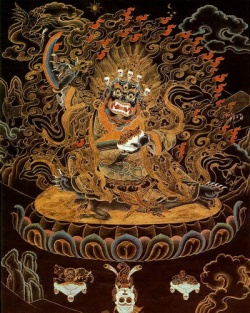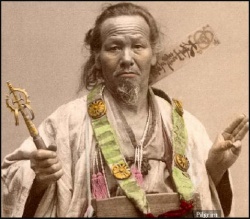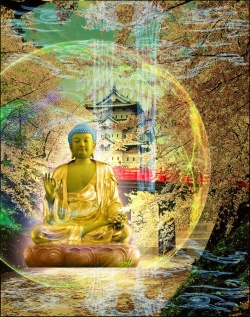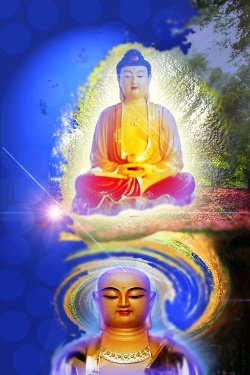Abhidhamma Studies: Buddhist Explorations of Consciousness and Time. By Venerable Nyanaponika Thera
Abhidhamma Studies: Buddhist Explorations of Consciousness and Time. By Venerable Nyanaponika Thera
Reviewed by Shrader, Douglas W.
Philosophy East and West
Hawaii, USA
p. 637 Abhidhamma Studies: Buddhist Explorations of Consciousness and Time
Philosophy East and West, Vol. 50, No. 4 (Oct. 2000)
The delightful, thought-provoking Abhidhamma Studies: Buddhist Explorations of Consciousness and Time by the Venerable Nyanaponika Thera is the fourth incarnation of a text originally composed shortly after World War II, published in 1949 (Frewin and Co., Ltd.).
The Buddhist Publication Society issued a second, revised and enlarged edition in 1965 as well as a third edition, with relatively minor corrections, in 1976. The present edition, edited by Bhikkhu Bodhi, incorporates a variety of welcome changes, reflecting considerable effort and devotion to the task. In addition to authoring a superb introductory essay, Bodhi has "reformulated a few awkward sentences..., reorganized the notes, provided additional references, and supplied a bibliography" (p. viii).
Perhaps the most intriguing and potentially significant change is evident in the title itself. Originally subtitled Researches in Buddhist Psychology, an apt but relatively uninformative description of its contents, the title now announces, even to the uninitiated, the book's unique, captivating subject matter: Buddhist Explorations of Consciousness and Time.
This book is essential reading for any serious student of Buddhism. Additionally, it will appeal to those interested in a wide variety of both phenomenological and ontological issues: the manifold of experience, the nature of consciousness, the analysis of time, concepts of anattā (ego selflessness) and paṭicca-samuppāda (dependent origination), and so forth.
An intermediate to advanced level of familiarity and understanding of basic Buddhist doctrines is recommended. It will prove particularly useful to scholars and students who have been intimidated by the vast, often cryptic, Abhidhamma literature.
Apparently, the Buddha and his teachings were as enticing and yet profoundly puzzling and enigmatic to his contemporaries and followers as they remain to millions today. They challenge everything we commonly take to be real. That which appears substantial, we are told, is not. Contrary to our own (unexamined) inner/ subjective experience, as well as the teachings of most major world religions, we neither are nor have a self, for there is no self either to be or to have.
The attempt to reconcile the teachings of the Buddha with existing beliefs and assumptions concerning the nature of reality led to a proliferation of competing philosophical schools. Each school developed its own distinctive Abhidhamma literature, ostensibly representing a deeper understanding of the teachings of the Buddha. In practice, the literature served to distinguish one school from another, guarding against and/or correcting the "erroneous" teachings of the other schools.
Over a period of approximately three centuries, the Abhidhamma Pitaka grew rapidly -- in terms of the sheer volume of literature as well as complexity of doctrine. Paralleling that increase, it came to play a position of ever greater prominence, rivaling even the canonical collections of the Buddha's word (the Sutta and Vinaya Pitakas). Together the three became known as the Tipitaka: "Three Baskets of the Doctrine."
Unfortunately for scholars, the only Abhidhammas to survive the widespread persecution of Buddhism in India during the twelfth century A.D. were those that had been transported to, and transplanted in, other lands. Specifically, the Theravāda Abhidhamma (seven books in Pāli) found an enduring home in Sri Lanka.
The Sarvāstivāda Abhidhamma (also seven books) along with the Śāriputra-abhidharma-śāstra (probably the Dharmaguptaka School) were carried to China, where they were translated from Sanskrit into Chinese. Of these, it is the Theravāda collection -- particularly its first book (the Dharmasanganī) as well as the seventh book (the Patthana) -- that forms the subject matter of Ven. Nyanaponika's study.
The other two schools have long since vanished, except, as Bhikkhu Bodhi points out, that "a late exposition of the Sarvāstivāda Abhidhamma system, Vasubandhu's Abhidharmakośa, continues to be studied among Tibetan Buddhists and in the Far East" (p. x).
Abhidhamma Studies is divided into five chapters and two appendixes. Chapter 1, which was added in the second edition, provides a brief historical overview of "The Abhidhamma Philosophy." Those who approach the Abhidhamma Pitaka expecting a discursive treatment of the nature of consciousness -- including philosophical questioning, speculation, and augmentation -- will be sorely disappointed. For the philosophical character of the literature is implicit, rather than explicit. The Pitaka, for the most part, consists of enumerations, lists, tabulations, and definitions.
Ven. Nyanaponika, noting the Buddha's interest in the liberating function of knowledge, characterizes the Abhidhamma as "the first historical attempt to map the possibilities of the human mind in a thorough and realistic way, without admixture of metaphysics and mythology" (p. 3). A few pages later he writes: "Here, for the first time in history, the human mind, so evanescent and elusive, has been subjected to a comprehensive, thorough, and unprejudiced scrutiny" (pp. 5-6).
The Abhidhamma, he explains, utilizes an inductive method. Because it is "based exclusively on an unprejudiced and subtle introspective observation of mental processes" (p. 6), there is little room, or need, for deductive argument. Because it employs a "rigorous phenomenology that disposes of the notion that any kind of static unity or underlying substance can be traced in the mind" (p. 6), the Abhidhamma can be used as a sort of inoculation or antidote to the human tendency to reify the self (anattā), as well as our tendency to isolate, reify, and compartmentalize the external world (dependent origination).
A brief but particularly insightful and well-written section of the first chapter is titled "Abhidhamma and Meditation" (pp. 10-12). Ven. Nyanaponika begins by observing that beliefs concerning the existence of a self, soul, or God are often fueled by misinterpreted meditative experience, including devotional rapture and mystical trance. Because the form of consciousness manifest in such an experience is so pure, so remarkable, and so unlike anything that the person may have experienced in any other context, it is hardly surprising that the person may, without ever recognizing the inferential nature of the conclusions, interpret the experience as
(1) the revelation of a God,
(2) mystical union with a divine spirit or principle, or
(3) the manifestation and realization of a true, lasting, eternal self.
Even if one avoids the obvious reifications, "the overwhelming impact of such meditative experience on the mind will produce a strong conviction of its reality and superiority" (p. 10). Fortunately, Ven. Nyanaponika explains,
The analytical method of the Abhidhamma gives immunity against such deceptive interpretations. In the Dharmasanganī the consciousness of jhāna, meditative absorption, is subjected to the same sober analysis as the ordinary states of mind. It is shown that meditative consciousness, too, is a transitory combination of impermanent, conditioned, and impersonal mental factors, which differ from their counterparts accompanying ordinary consciousness only in their greater intensity and purity. They thus do not warrant any assumption of a divine manifestation or an eternal self. (p. 11)
In chapter 2, "The Twofold Method of Abhidhamma Philosophy," Ven. Nyanaponika reiterates the claim that Abhidhamma Philosophy is an instance of phenomenology rather than ontology. (In his introductory essay, Bhikkhu Bodhi makes a reasonable argument for regarding it as both, provided one adopts a suitably broad definition of "ontology" [p. xvi].) The twofold method to which he refers is that of analysis (represented in the Dharmasanganī) combined with the investigation of the relations/conditionality of things (represented in the Patthana).
"The mere juxtaposition of these two basic schemata," he writes, "already allows us to formulate an important axiom of Buddhist philosophy: a complete description of a thing requires, besides its analysis, also a statement of its relations to other things" (p. 22). Investigating relations between things naturally leads to a discussion of time (samaya), dependent origination (paṭicca-samuppāda), and insubstantiality (sunnatā).
Even a single moment of consciousness ("the smallest accessible psychic unit") is regarded not as atomic but rather as "a correlational system of its factors, functions, energies, or aspects" (i.e., dhammā) (p. 23).
The first part of the Dharmasanganī is called "the Consciousness Chapter" (cittuppādakanda). Ven. Nyanaponika describes its purpose as providing " (1) a classification of all consciousness and (2) a detailed analysis of the single types of consciousness" (p. 34). The core of his own text, Abhidhamma Studies, "is based on the first type of wholesome consciousness dealt with in the first paragraph" of that part (p. 31). The question is asked, "Which are the things that are wholesome?" The answer is given:
At a time when a state of wholesome consciousness belonging to the sensuous sphere has arisen accompanied by joy and associated with knowledge (and spontaneous), referring to any one object, be it an object of sight, sound, smell, taste, a tangible object, or a mental object -- at that time there are present:.... (p. 31 )
-- and here follows an enumeration of fifty-six items divided into twelve categories: the pentad of sense-contact, factors of absorption, faculties, and so forth. The presentation and overview of the list, in chapter 3, requires less than fifteen pages.
Chapter 4, "The List of Mental Constituents in the Dharmasanganī," is eleven times that length.
Here, Ven. Nyanaponika not only provides useful commentary concerning the fifty-six items listed in the previous chapter, but also engages in a rather interesting attempt to make sense of the order of classification. Convinced that the Abhidhamma Pitaka is a product of the intuitive insight of the Buddha himself, Ven. Nyanaponika is convinced that the apparent randomness or repetitiveness of some of the items is testimony only to the fact that we have not yet understood consciousness in the same way or with the same systematic clarity that the Buddha understood consciousness.
Thus he treats Abhidhamma as a vehicle for meditation -- and introspective examination and reflection -- rather than as a series of scientific or philosophical claims subject to doubt, debate, and so forth.
In the fifth and final chapter, "The Problem of Time," Ven. Nyanaponika focuses his reflections on temporal relations. Here, for example, we find a clear and patient presentation of five different senses of time (samaya): duration (kāla), concurrence of circumstances (samavāya), combination of modes of conditionality (hetu), the right moment (khana), and the momentary union/aggregation of single components of consciousness (samūha) (pp. 94-95). Far from being relegated to the end of the book as an afterthought, time permeates the entire text. Throughout the book one finds tantalizing claims such as the following, in chapter 4:
The relational system of the functions within a single moment of consciousness extends not only to the future but also to the multiplicity of past states of consciousness that are its conditions. That is to say: mental factors, far from being self-contained units, are "open" toward the past as well as the future, and, though meeting in one moment, they are related to quite different "layers" of those time periods. From that we can gauge the highly dynamic nature of the processes going on in a single moment of consciousness. (p. 40)
In the first appendix, Ven. Nyanaponika takes Mrs. Rhys Davids to task for casting doubt on the authenticity of the Anupada Sutta as a genuine discourse of the Buddha. The second appendix, "The Omission of Memory from the List of Dhammas," is brief but extraordinarily interesting. Anyone interested in the nature of memory would do well to read these five pages.
I heartily recommend reading this relatively brief text from cover to cover. Improved understanding of each part facilitates understanding of all the others. Additionally, some portions, especially chapters 3 and 4, serve as sort of textual commentary to which one may return multiple times for fresh insight and meditative sustenance.
Source






